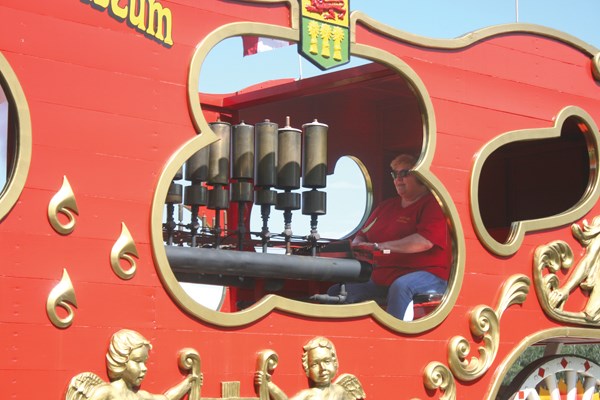Arlene Shiplett climbs the circus wagon, making sure to avoid the black pipes. The boiler at the front of the wagon is chugging along, pumping hot water through the pipes. Shiplett has burned her skin on them a few times. That’s why she’s wearing jeans in the middle of a hot summer day. They provide a layer of protection if she accidently bumps into a pipe.
Shiplett settles into her seat. A small keyboard lies in front of her. Piano wire connects it to a collection of whistles, some large, some tiny. They were built in 1955. They’re connected to the boiler and the pipes.
Shiplett nods and presses down on the keyboard. Steam erupts from the whistles. They emit high-pitched squeals, all at different tones. Shiplett runs her finger over the keys. If you focus, you can hear the skeleton of a melody beneath the shrieking. She’s playing the theme from “The Flintstones.”
Shiplett is playing a calliope, a piano that creates sounds through steam. This calliope is owned by the Western Development Museum (WDM). It’s one of two functioning calliopes in Canada.
Shiplett tours the calliope across Saskatchewan during the summer. She plays at parades, fairs, and other events. She played at the 62nd Threshermen’s Show and Seniors’ Festival this past long weekend.
Shiplett, a professional horn player, didn’t set out to study the calliope. She was a summer student with WDM when they asked her if she wanted to try playing it. Their full-time calliope player was retiring, so they needed a replacement.
“I tried it, fell in love with it, and kept playing,” she says.
The calliope’s heyday was the mid-nineteenth to early-twentieth century. They were played on riverboats and at carnivals. Their high-pitched notes were designed to rise above the fray and attract attention.
“In the old days, you would follow the sounds of the calliope out to the circus grounds up and down the Mississippi,” Shiplett says.
Originally, Shiplett would only play songs from the calliope’s era, but after a while, she wanted to play more contemporary tracks. She’ll play everything from “The Hockey Song” to “I’ve Got a Lovely Bunch of Coconuts.” Every year, she learns two or three new songs.
“I rarely repeat a song during the day,” she says. “I’ve got about 140 songs on my playlist.”
Shiplett keeps busy teaching music and playing orchestras. But the calliope fits in perfectly as a summer pastime.
“This is a nice break from my regular life,” she says. “It’s been a great gig all around.”




